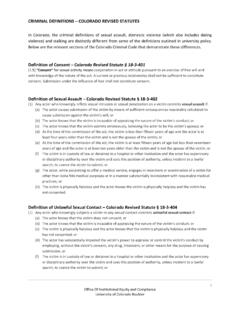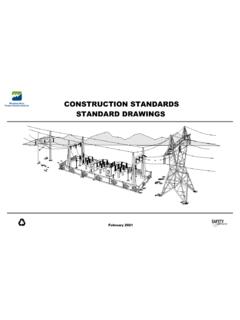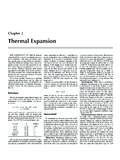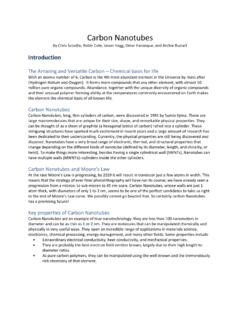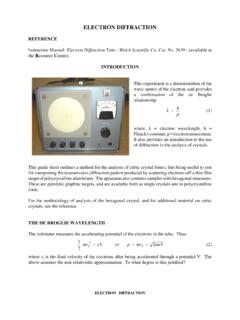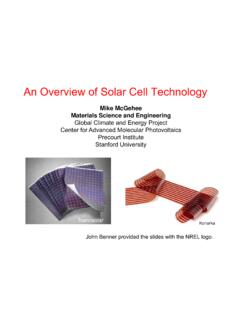Transcription of Materials for Aircraft Engines - University of Colorado ...
1 ASEN 5063 Aircraft Propulsion Final Report 2015 Materials for Aircraft Engines TAKEHIRO OKURA Contents 1. Overview .. 2 2. Fan Section .. 3 Fan Blade .. 3 Fan Case .. 4 3. Compressor Section .. 5 4. Combustor Section .. 5 5. Turbine 6 Turbine Blade .. 6 Ni-based superalloys .. 8 6. Shaft .. 9 7. Conclusion .. 10 8. Appendix - compositions of Materials - .. 10 9. References .. 12 1. Overview In 1939, the world s first jet plane flew in the sky in Germany. A jet engine in this jet plane was designed by Dr. Ernst Heinkel, a German Aircraft designer. The basic configuration of jet Engines has not changed up until now, and the engine is composed of an air intake, a compressor or a fan, a combustor or a combustion chamber, a turbine and an exhaust nozzle. (Figure 1) Thereafter, aerodynamic design technology for a compressor and a turbine, cooling technology for turbine blades, and advances in material technology have significantly improved jet engine performance.
2 (Figure 2) Figure 1. Basic configuration of a jet engine Figure 2. Improvement of specific fuel consumption In recent years, civil Aircraft Engines are expected to have a further improvement in specific fuel consumption (SFC) in terms of economy. Because further weight reduction and higher efficiency of the engine can lead to improvement of SFC, the development of structural Materials in particular heat-resistant alloys in hot sections is an essential task in addition to advances in design and manufacturing technology. These Materials will be chosen based on material properties such as the low density, high strength, workability, and heat-resistant property. This paper describes the latest developments of Materials for Aircraft Engines , mainly for the General Electric Engines . In addition, compositions of Materials used in each engine section are summed up in the Appendix.
3 2. Fan Section The Fan section is responsible for taking air into the engine . Even though the heat restriction is not strict, the fan should be made of light and high-specific-strength Materials due to strong centrifugal forces. It is also important to have high stiffness so that it can prevent torsional distortion. In recent years, in order to obtain high propulsion efficiency, the fan has become bigger to have high bypass ratio, and the fan weight has become heavier. Therefore, the GEnx Engines utilize composite Materials and latest aerodynamic design technology for reducing the weight. Fan Blade Titanium, aluminum and stainless steel have been used in the fan blades, and titanium is often used because of its high strength to weight ratio, corrosion resistance, and creep resistance. For the GEnx Engines , the fan blades are composed of Carbon Fiber Reinforced Plastic composite (CFRP) blades and titanium leading edge (Ti-6Al-4V alloys), which was introduced in the GE90 engine , for improving the impact damage resistance in case of bird strikes.
4 (Figure 3 and 4) Figure 3. Fan blade in the GE90 Figure 4. Microstructure of Ti-6Al-4V alloys As shown in Figure 4, TiAland AlTi3phases in Ti-6Al-4V alloys constitute a lamellar structure. In terms of mechanical properties, a lamellar structure shows more resistance against creep and fatigue crack growth and higher toughness. Especially, Ti-6Al-4V alloys show high-temperature strength below approximately C 800. As a supplement, the forward-swept wing type is adopted as a result of the latest three dimensional aerodynamic design technology. This improves the aerodynamic performance and also is able to reduce the number of fan blades from 22 to 18, which reduces weight and the number of parts. (Figure 5) Fan Case The fan case is the heaviest part in the engine ; therefore, in general, relatively light Materials such as titanium, Aluminum, and CFRP are used for the fan case.
5 For the GEnx Engines CFRP is adopted as in Figure 5. This composite case is composed of composite Materials which is laminated fiber fabrics having a specific gravity of about half of the metal case, which realizes weight reduction and at the same time satisfies safety requirements of the containment property in case the fan blade is off. In addition, this CFRP case shows high durability against damage, fatigue, and corrosion. Figure 5. Composite Technology advancement in the GE Engines 3. Compressor Section The Compressor section is responsible for compressing air which is taken into the engine by the fan. Due to compressing air, the temperature in the section begin to rise; therefore, Materials having high-temperature strength are used such as Fe-, Ni-, and Ti-based alloys. For the GEnx Engines , they have high compression ratios by using two compressor sections, a seven stage low-pressure compressor and a ten stage high-pressure compressor.
6 Also, the low-pressure compressor spins counter-clock wise, and the high-pressure compressor spins clockwise, which realizes improvement of fuel efficiency. The low-pressure compressor blades and several high-pressure compressor blades are made of Ti-6Al-4V alloys which are also used for the fan blade, and the rest of high-pressure compressor blades are made of Ni-based superalloys such as Hastelloy X. In recent years, Ti-based alloys have become to be used for the high-pressure compressor section in order to reduce weight, and for the same purpose Ti-based alloys such as Ti-6242 (Ti-6Al-2Sn-4Zr-2Mo) is used in the middle section exposed to high temperature. 4. Combustor Section The Combustor section, after the compressor section, is responsible for mixing the compressed air with fuel and igniting the mixture of air and fuel. This provides a high temperature and high energy airflow generating the power to propel an Aircraft .
7 The temperature in combustor can reach to approximately C 1000, so this section needs to be made of heat-resistant alloys such as Co- and Ni-based superalloys. (Table 1) To improve mechanical properties of the superalloys, several additives will be selected such as Aluminum (Al) and Titanium (Ti) for strength, Chromium (Cr) for corrosion resistance, and Molybdenum (Mo), Tungsten (W) and Rhenium (Re) for increasing high-temperature strength. The microstructure of Ni-based superalloys is introduced in Section 5. Table 1. Combustor Materials 5. Turbine Section Turbine Blade The Turbine section is responsible for generating the power to rotate other parts; the fan, compressor and combustor. The rotation of the turbine blades is generated by the combustion air and is transmitted to the rotation of the shaft which goes through four sections introduced so far and therefore rotates in a wide operating temperature range.
8 In the engine , the turbine section is exposed to the harshest environment in terms of temperature and pressure. (Figure 6) Therefore, the Materials of turbine section need to satisfy many requirements such as high creep strength, high temperature fatigue strength, and high temperature corrosion resistance. The turbine Materials in high pressure and temperature section are generally Ni-based superalloys because of their high creep strength, while the Materials in low pressure and temperature section can be stainless steels, Co-, and Ni-based superalloys. Since the turbine blade temperature exceed C 1200and can reach to C 1500 in the latest Engines , cooling passages design, zirconia (2 ZrO) for thermal barrier coating, and Ni-Co-Cr-Al-Y alloys for high temperature corrosion resistance can be used in order to improve turbine blade performance.
9 (Figure 7) Figure 6. Temperature and pressure at which each part of the engine is exposed Figure 7. Design for turbine blade cooling passages (Left) and Rough design of thermal barrier coating (Right) For the GEnx-1B, the turbine section has seven low-pressure stages and two high-pressure stages. The latter two low-pressure stages (sixth and seventh) are made of TiAl alloys in order to reduce weight, and the rest of low-pressure stages and high-pressure stages are made of Ni-based superalloys such as Rene N5 manufactured by GE. Table 2 shows the nominal compositions (wt%) of common Ni-based superalloys. Table 2. Nominal composition, wt% of Ni-based superalloys Ni-based superalloys There has been a great attention for the combined cycle system to improve power generation. The improvement of the system is known to lead to high fuel efficiency and also to decreasing the carbon emission.
10 For the improvement, the gas turbine entry temperature (TET) should be increased by developing superalloys which show their great heat-resistant properties. The common superalloys for the gas turbine inlet would be Co- and Ni-based superalloys. Co-based superalloys used to be main Materials of the gas turbine blade. However, after the development of Ni-based superalloys, the Co-based turbine blades were replaced with Ni-based turbine blades. There are several reasons for the replacement. Firstly, in terms of Clarke number, which shows the content of the chemical elements (weight percentage, wt%) in the surface of the earth, the content of Nickel element is more than that of Cobalt elements; namely, the rarity of Nickel is respectively low. Second reason is Nickel crystal structure, which is that the face centered cubic (FCC) structure, atoms located at each cube corner and the centers of each cube face.








